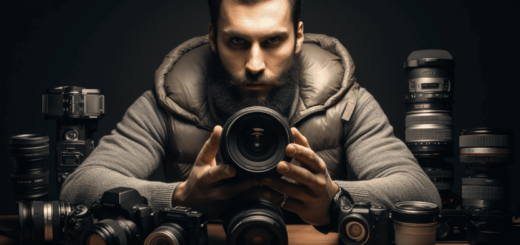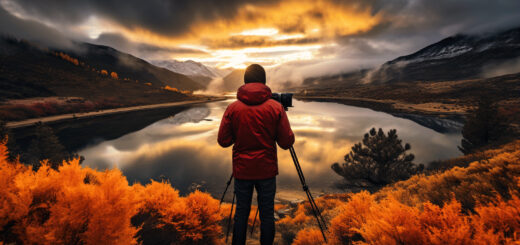The Art of Choosing the Perfect Camera Lens
Finding the perfect camera lens can be an overwhelming task, especially with the vast array of options available in the market today. Whether you’re a professional photographer or an amateur enthusiast, choosing the right lens is crucial for capturing stunning and high-quality images. With advancements in lens technology, the options have only expanded further, offering photographers greater control and creative possibilities.
In this article, we will delve into the art of choosing the perfect camera lens. We will explore the evolution of camera lens technology, the impact of new lens systems, and provide valuable insights on choosing the right lens for your specific needs. Whether you’re passionate about landscape photography, sports events, or architectural shots, we’ve got you covered.
So, grab your camera and get ready to discover the world of lenses. Let’s dive in and unlock the secrets to capturing breathtaking images with the perfect lens!
Evolution of Camera Lens Technology
Photography has come a long way since its earliest days, and one of the most crucial aspects of capturing stunning images is the camera lens. Over the years, advancements in lens technology have revolutionized the way we capture and perceive the world through photography. From improvements in optical zoom performance to the integration of artificial intelligence (AI) algorithms, camera lenses have evolved significantly. In this article, we will explore some of the key milestones in the evolution of camera lens technology.
Improvements in Optical Zoom Performance
One of the noticeable advancements in camera lens technology is the improvement of optical zoom capabilities. In the past, photographers relied on fixed focal length lenses, which limited their ability to zoom in or out without physically moving closer or farther away from the subject. However, with the introduction of variable focal length lenses, photographers gained the ability to adjust their focal length without changing lenses.
Optical zoom lenses utilize multiple lens elements that can be adjusted to achieve different focal lengths. This allows photographers to capture close-up shots with higher magnification and to zoom out for wide-angle shots. The ability to zoom in and out seamlessly has opened up new possibilities for photographers, allowing them to capture dynamic perspectives across a wide range of subjects and scenes.
Artificial Intelligence in Camera Systems
The integration of artificial intelligence (AI) algorithms into camera systems has brought about significant improvements in image quality and settings optimization. AI-powered algorithms analyze various factors, such as lighting conditions, subject positioning, and image composition, to make intelligent adjustments in real-time. This technology has become particularly helpful in smartphone camera systems, where the space for physical lens elements is limited.
AI algorithms can optimize image settings, such as exposure, white balance, and color saturation, to deliver stunning results even in challenging lighting conditions. These algorithms can also recognize different scenes or subjects and automatically adjust the camera settings accordingly, ensuring that every photo captured is well-balanced and visually appealing.
Introduction of Liquid Lenses
Another notable development in camera lens technology is the introduction of liquid lenses. Liquid lenses are a type of adjustable lens that can change its shape or focal length by utilizing an electric current. Unlike traditional camera lenses with moving mechanical parts, liquid lenses offer a flexible and compact solution for focusing on subjects.
Liquid lenses can rapidly adjust focus, allowing for faster and more accurate autofocus performance. This technology has proven to be valuable in various applications, including smartphones and digital cameras, where quick and precise autofocus capabilities are essential. Additionally, liquid lenses offer the potential for thinner and lighter lens designs, making cameras more portable without compromising on image quality.
As camera lens technology continues to evolve, photographers can expect to see further exciting developments and enhancements in the future. The transformation in camera lens technology, the emergence and use of AI algorithms in optimizing image settings, and the growing trend towards flexible imaging systems with liquid lenses are just a few examples of how technology is advancing the field of photography.
For a deeper understanding of the history and evolution of camera technology, you can refer to this comprehensive article on the History and Evolution of Camera.
Impact of New Lens Systems
Photographers and videographers are always on the lookout for new lens systems that can enhance their creative abilities and push the boundaries of their work. In recent years, Canon’s RF mount system has made waves in the industry with its innovative technology and cutting-edge features. Two lens systems in particular have caught the attention of professionals and enthusiasts alike: Full Frame Zoom Lenses and Tilt Shift Lenses.
Full Frame Zoom Lens
One of the standout features of Canon’s RF mount system is the introduction of the world’s first full-frame zoom lens with a maximum focal length of up to 800mm[1]. This technological breakthrough opens up a whole new range of possibilities for photographers looking to capture distant subjects in stunning detail. Whether you’re shooting wildlife, sports, or even astrophotography, having such a versatile zoom lens in your arsenal can make a world of difference.
With a wide range of focal lengths available, a full-frame zoom lens allows photographers to quickly and easily adjust their composition without the need to switch lenses or compromise image quality. This level of flexibility is especially useful in fast-paced shooting situations, where every second counts. It’s no wonder that professional photographers are applauding the introduction of this groundbreaking lens system.
Tilt Shift Lenses
Another lens system that has garnered attention in Canon’s RF mount system is the tilt-shift lens. These lenses serve a unique purpose in allowing photographers to have precise control over depth of field and the ability to change the plane of focus. This makes them an invaluable tool for architectural photography, product photography, and creative portraiture.
By tilting the lens, photographers can create a selective focus effect, where only a specific part of the image is in sharp focus while the rest gradually blurs away. This technique can add a sense of depth and dimension to an image, drawing the viewer’s attention to the intended subject. Furthermore, by shifting the lens, photographers can correct perspective distortion, ensuring that vertical lines remain straight and parallel in architectural shots.
The importance of tilt-shift lenses in the world of photography cannot be overstated. They offer a level of control and creative freedom that is unmatched by any other lens system. Photographers who have had the pleasure of using tilt-shift lenses with Canon’s RF mount system have praised their exceptional image quality and the ability to capture truly unique and visually captivating shots.
In conclusion, Canon’s RF mount system has introduced two game-changing lens systems: Full Frame Zoom Lenses and Tilt Shift Lenses. These advancements have revolutionized the capabilities of photographers, enabling them to capture breathtaking shots with unprecedented control and creativity. Whether you’re a seasoned professional or an aspiring artist, investing in these lens systems will undoubtedly take your photography to new heights.
[1]: Canon Official Website – RF 100-500mm F4.5-7.1 L IS USM
Choosing the Right Lens
When it comes to photography, the lens you choose can make all the difference. It’s like selecting the right brush for a painter or the perfect tool for a carpenter. Each lens has its own unique characteristics and strengths, so it’s essential to select one that suits your needs and style of photography.
Based on Type of Photography
First and foremost, consider the type of photography you’ll be focusing on. Whether you’re shooting sports, landscapes, portraits, or wildlife, different lenses excel in capturing different subjects. Here are a few recommendations for specific types of photography:
- Telephoto Zoom Lenses for Sports and Theater: If you’re capturing fast-moving action, such as sports or theater performances, a telephoto zoom lens, like a 70-200mm, would be ideal. It allows you to zoom in close to the action and capture those decisive moments with clarity and precision.
- Prime Lenses for Landscape Shots: For breathtaking landscape shots, prime lenses between 24mm and 35mm are highly recommended. These lenses offer a wide field of view, allowing you to capture the expansive beauty of nature in all its glory.
Maximum Aperture Considerations
Another crucial factor to consider is the maximum aperture of the lens. The aperture determines how much light the lens can gather and how shallow the depth of field can be. This affects the overall image quality and the ability to achieve that beautiful background blur (also known as bokeh). Keep in mind:
- Impact of Maximum Aperture on Image Sharpness: Generally, lenses with wider maximum apertures (lower f-numbers) tend to produce sharper images, especially in low-light conditions. They allow for faster shutter speeds, reducing the chance of blur due to camera shake.
Difference in Image Quality Between Lens Types
When comparing lenses, it’s important to understand the differences between zoom lenses and prime lenses:
- Key Differences Between Zoom Lens and Prime Lens: Zoom lenses offer flexibility, allowing you to zoom in and out to frame your subject. On the other hand, prime lenses have a fixed focal length, which can help you achieve sharper images and better bokeh due to their wider maximum apertures.
Weight, Size, and Compatibility
Last, but certainly not least, consider the weight, size, and compatibility of the lens. These factors can greatly impact your comfort and ease of use, especially if you plan on carrying your camera and lenses for extended periods. Here’s why these factors matter:
- Importance of Lens Weight, Size, and Compatibility: A heavy and bulky lens may cause fatigue and limit your mobility. Additionally, ensure that the lens you choose is compatible with your camera body. Some lenses may only work with specific camera models or sensor sizes.
Remember, choosing the right lens is a personal decision that depends on your artistic vision and shooting style. Experiment with different lenses, seek advice from other photographers, and take into account the tips from this comprehensive article on choosing camera lenses. Happy shooting!
Effects of Focal Length and Aperture
Captivating Introduction:
When it comes to photography, understanding the effects of focal length and aperture is key to capturing stunning images. These two factors play a significant role in determining the look and feel of your photographs. In this section, we will explore how focal length and aperture can impact your images and offer some tips on how to make the most of these settings.
Gather More Light with Wider Aperture
One of the main effects of aperture is its impact on the amount of light that enters the camera. The aperture refers to the opening in the lens that controls the amount of light hitting the image sensor. By adjusting the aperture size, photographers can control the exposure of their photos. Here’s how a wider aperture can help gather more light:
- Faster Shutter Speeds: When you widen the aperture, more light is able to pass through the lens, allowing for faster shutter speeds. This is particularly useful in low-light situations, such as capturing nightscapes or indoor shots without a flash. With a wider aperture, you can maintain a fast shutter speed while still capturing properly exposed images.
- Bokeh Effect: Another advantage of using a wider aperture is the ability to create a beautiful bokeh effect. Bokeh refers to the aesthetic quality of the out-of-focus areas in an image. With a wider aperture, the depth of field becomes shallow, resulting in a blurred background while keeping the subject in sharp focus. This can draw attention to the subject and provide a sense of depth and dimension to your images.
Did you know? Wider apertures are often denoted by smaller f-numbers. For example, an aperture of f/1.8 is wider than an aperture of f/5.6.
Wide-Angle Lenses for a Larger Appearance
In addition to aperture, focal length also plays a crucial role in photography. Focal length determines the magnification and angle of view of a lens. Here’s how wide-angle lenses can create a larger appearance in your images:
- Greater Perspective: Wide-angle lenses have a shorter focal length, allowing them to capture a wider field of view compared to standard or telephoto lenses. This wider perspective can make scenes appear more expansive and immersive. It’s particularly useful for landscape photography or capturing architecture where you want to include as much of the scene as possible.
- Distortion and Proximity: Wide-angle lenses can introduce some distortion near the edges of the frame, giving your images a unique and dynamic look. This distortion can enhance the sense of depth and create a sense of proximity, making your subject appear larger or closer than they actually are.
Extra Tip: When shooting with a wide-angle lens, be mindful of keeping your subject closer to the center of the frame to avoid excessive stretching or distortion near the edges.
Wrapping it up:
Understanding the effects of focal length and aperture allows photographers to have more control over their images and achieve the desired look. By experimenting with wider apertures, you can gather more light and create stunning bokeh effects. And with the use of wide-angle lenses, you can capture a larger appearance and add a unique perspective to your photos. So grab your camera and start exploring the world through a wider lens!
To learn more about wide-angle lens tips and techniques, check out this comprehensive guide.
Conclusion
In conclusion, the art of choosing the perfect camera lens is a crucial aspect of photography that shouldn’t be overlooked. The advancements in camera lens technology, such as improvements in optical zoom performance, the integration of artificial intelligence in camera systems, and the introduction of liquid lenses, have significantly enhanced the capabilities of modern cameras.
Understanding the impact of new lens systems, such as full-frame zoom lenses and tilt-shift lenses, can open up new creative possibilities and help photographers capture stunning images with ease.
When choosing the right lens, it’s essential to consider factors such as the type of photography you’ll be doing, whether it’s sports, landscapes, or portraits. Telephoto zoom lenses are perfect for capturing action-packed moments in sports or theater, while prime lenses excel at capturing the intricate details of landscapes. Maximum aperture considerations, the difference in image quality between lens types, and the weight, size, and compatibility of the lens should also be taken into account.
The effects of focal length and aperture play a significant role in the overall look and feel of your photographs. Wider apertures allow you to gather more light, resulting in brighter and sharper images, while wide-angle lenses give your photos a larger appearance, perfect for capturing expansive landscapes or architectural details.
In the end, choosing the right camera lens is a personal decision that depends on your unique photography style, preferences, and budget. By understanding the technical aspects and considering your specific needs, you can find the perfect lens that helps you bring your creative vision to life. So start experimenting, explore the possibilities, and let your photography skills shine with the perfect camera lens.
For more helpful articles, camera reviews, tips, and tricks for your photography projects, be sure to visit Wimarys.com. Discover a wealth of knowledge and inspiration from Wim Arys, a talented and experienced photographer specializing in portrait and landscape photography, with a focus on Sony mirrorless cameras. Capture unforgettable moments and elevate your photography game with Wim Arys Photography.
Frequently Asked Questions
- What factors should I consider when choosing a camera lens?
When choosing a camera lens, consider factors such as focal length, aperture, lens type, image stabilization, compatibility with your camera body, and your intended use or photography style.
- What is the difference between prime and zoom lenses?
Prime lenses have a fixed focal length, meaning they cannot zoom, but they often offer superior image quality, wider maximum aperture, and are generally smaller and lighter. Zoom lenses, on the other hand, have a variable focal length and allow for zooming in and out.
- What is the significance of aperture in a camera lens?
Aperture refers to the size of the lens opening, which affects the amount of light that enters the camera. It also determines the depth of field, influencing how much of the image is in sharp focus and how much is blurred.
- Should I invest in lenses from the same brand as my camera body?
While using lenses from the same brand as your camera body may offer some advantages, such as better compatibility and seamless integration, there are many reputable third-party lens manufacturers that produce high-quality lenses. It’s important to consider factors such as lens specifications, reviews, and overall performance rather than solely focusing on the brand.
- Which lens is best for portrait photography?
For portrait photography, a lens with a focal length between 50mm and 85mm is commonly recommended. Prime lenses with wide maximum apertures, such as f/1.4 or f/1.8, are great for achieving a shallow depth of field and beautiful background blur, also known as bokeh.



